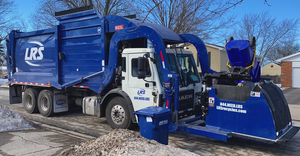Niagara Falls, N.Y., Solid Waste Ordinance Helps Increase Recycling Rate
Since the first refuse and recycling carts landed at the doorsteps of Niagara Falls, N.Y. businesses and residences in August, the city’s dismal 4 percent recycling rate has risen to 14 percent and continues to climb.
Torn trash bags, large bulk items and other waste left outside of city-provided trash carts are a violation of the city’s ordinance for its Solid Waste Refuse and Recycling Program. The city distributed the carts months in advance to allow a grace period for residents before the ordinance became law at the first of the year.
The need was there, says City Administrator Donna Owens. The city heard citizen complaints about rodent control and other refuse-related concerns that contributed to the new system for trash pickup, she says.
“We hadn’t changed our ordinance in over 40 years,” says Owens.
As the city’s previous private solid waste contract was ending, the timing was right for the change.
“What we were thinking about doing was coming online with containerizing the waste. And also giving citizens an opportunity to reduce waste by recycling more. Our premise was to recycle more in the city of Niagara Falls, because we had one of the lowest recycling rates in Western New York,” says Owens.
The buy-in from businesses and citizens has been slow, but that was expected, which is why the city allowed for the grace period.
“Change is always difficult,” says Owens.
Though many residents requested a change, there was some pushback on the cart program. After decades of the status quo, changing behaviors can be challenging, says Owens.
“Through those challenges though, the majority of people are doing it.”
Owens estimates at least 80 percent of customers are in compliance.
The city, which used local casino funds to pay for the new program, also created a Solid Waste Education and Enforcement Team (SWEET) tasked with educating the public on proper waste disposal and recycling.
SWEET Program Coordinator, and currently its sole employee, Brook D’Angelo says the ordinance limits curbside trash to a 64-gallon cart, and offers a larger, 96-gallon container for recycling.
Residents recycle every other week and it is not mandatory, says D’Angelo.
“Now believe me, there are some people who can fill that 96-gallon recycling cart in one week. To accommodate that, there is no limit to recycling. If there’s additional recycling, they can place it out neatly next to the recycling cart on recycling day.”
As liaison between the citizens and haulers, Modern Corp., D’Angelo handles any issues that arise. Right now, she says, she spends time educating residents on recycling and directing those with excess trash to pick up a “free dump” permit that allows them to take trash to any city-contracted landfill.
The city also has approved two temporary enforcement officers who are likely to come aboard by month’s end, says D’Angelo.
While, enforcement plays a role, she says, education is the main focus.
The first time around, violators get what we call an ‘Oops Tag’ where the violation is explained and residents educated. Some, she says, may not recognize their mistake. If there’s a second violation within 12 months, there’s a $35 fine, a second results in a $75 fine and so on, says D’Angelo.
“If someone constantly violates the ordinance an appearance ticket can be issued where they have to go in front of a judge,” she says.
If it’s a situation, for example, where 30 bags are at the curb or the entire contents of an apartment are out at the street, a separate enforcement team, under the city’s Clean Neighborhoods program, would handle it.
The SWEET program mainly deals with cart violations such as piling bags on top of the cart, or putting excess trash in with recycling.
And most customers are complying, D’Angelo says.
“What happens is, the people who don’t are going to stick out like a sore thumb. So they’re going to be very noticeable.”
At year’s end, Owens says the city will establish a recycling goal, and complete performance measures that go along with it. The city is tracking the recycling rate quarterly, and the 10 percent increase came after the carts were distributed but before the ordinance officially went into effect.
“That’s a great response”, she says. “It hasn’t been easy, but it’s a great response.”
About the Author
You May Also Like


